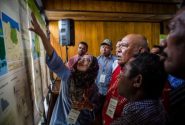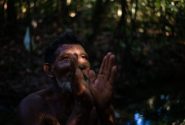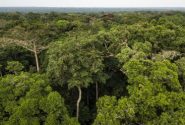
Delegates at the U.N. meeting in Bonn will debate whether a REDD+ governing body will help the emissions reduction scheme out of its current impasse. Adopt A Negotiator
BONN, Germany (31 May, 2013) – Negotiators attending a U.N. climate change conference next week are expected to propose setting up a REDD+ governing body, which could help provide a solution to how countries monitor, report and verify successful emissions reductions.
It would also determine how financial support would be disbursed.
REDD+ is a mechanism that channels money to developing countries to encourage the adoption of policies and practices that reduce emissions from deforestation and forest degradation. But progress stalled last December in Doha due to a failure by countries to agree on how REDD+ would be monitored and verified for success, which is linked to how countries would be compensated for their achievements.
Deforestation and forest degradation – largely through agricultural expansion, conversion of forest to pastureland, infrastructure development and fires — account for 10 percent to 15 percent of all global greenhouse gas emissions, more than the entire global transportation sector and second only to the energy sector.
Delegates at the meeting in Bonn, Germany, which will take place from June 3 to 14, will debate whether a REDD+ governing body tasked with organizing the flow of financial support and establishing the verification processes will help the emissions reduction scheme out of its current impasse.
“We should have known by Doha (where the previous climate change summit was held), how emissions reductions should be reported and verified,” said Louis Verchot, Director at the Center for International Forestry Research (CIFOR).
“We don’t know because we haven’t yet settled the debate over who does the verification and as a result, there’s also no agreement on how money should flow.”
Making monitoring, reporting and verification processes work
Making the yet-to-be created REDD+ body an operational entity with real powers, rather than giving it just an advisory role, could help overcome the current impasse between developing countries and developed countries to agree how the REDD+ mechanism should evolve, Verchot said.
“There are two modes that this body could take,” he said. “The first is an advisory role in which the body facilitates and advises on how money should flow through different financial streams, such as those now being coordinated by the World Bank’s Forest Carbon Partnership Facility and UN REDD.”
The Forest Carbon Partnership Facility aids developing countries in REDD+ efforts.
The body could advise on technical capacity needs and make recommendations for funding activities that can overcome technical constraints,” Verchot said.
“The second mode — making it an operational entity — would give it more bite, he added.
REDD+ is the one scheme which developing countries stood behind and said: ‘This is an action to which we’d like to contribute.’ If we can’t take this contribution from developing countries and make it functional, then it’s a sad state of affairs.
“The body would set standards for validation, have legal standing, accept and disburse money — and if you can tie verification to that, you can overcome the impasse between developing countries and developed countries.”
At the Doha 18th Conference of Parties (COP18) in 2012, negotiations ground to a halt over how to verify carbon emissions and how verification processes should be financed. Specifically, the impasse – reported to be between Brazil (a potential beneficiary of REDD+) and Norway (the largest funder of tropical forest conservation) – revolved around language governing the standards by which deforestation-related emissions would be verified.
Norway has been pushing for an independent, international verification process undertaken by experts, but Brazil and other developing nations have said they are not willing to commit to external verification requirements.
“A multi-lateral body represents a way for developing countries to have their hands on the steering wheel as equals with developed countries,” Verchot said.
“It would give them some control over the process and how it is implemented. At that level, it becomes a middle ground – it’s not developed countries sending in their teams of experts; it’s a joint-verification initiative.”
Making the money flow
Once mechanisms for monitoring, reporting and verifying successful emissions reduction have been agreed upon, it is up to developed countries to “pony up the money and get finances flowing, whether it be through mobilizing private sector money or public money that is truly additional and has not already been earmarked for official development assistance (ODA),” Verchot said.
To kick-start environmental projects like those implemented under REDD+, the Green Climate Fund (GCF) — a funding mechanism of the UNFCCC that transfers money from developed countries to developing ones, created Fast Start Funding, which was supposed to have disbursed $30 billion from 2010 to 2012.
However, only over a third of that sum was reportedly collected from developed countries, and commentators question the extent to which this fund represents new and additional resources that are separate from ODA.
This raises doubt as to whether the GCF would be able to deliver on its goal of raising $100 billion annually by 2020 for environmental projects, according to Verchot.
“The reason we’ve fallen short in securing the money is that we’ve been unable to secure long-term emissions reduction commitments from developed countries,” he said.
“We had a five-year period (under the Kyoto Protocol) that ended in 2012 and we’re now in the second period but with no real commitments, and with no decision on what the commitments should be.”
In 2011, Canada became the first nation to pull out of its commitments and pledges to the Kyoto Protocol. The country said it did not want to “devote scarce dollars to capitalize the new Green Climate Fund…until all major emitters accept legally binding reduction targets and transparent accounting of greenhouse gas inventory.”
Meanwhile, the United States and China — the world’s largest emitters — have not made any legally binding commitments for reducing their emissions.
“It’s hard to get countries that are polluting less to take on commitments when the big polluters aren’t willing to take action,” Verchot said. “As long as fossil fuel use is not penalized, at least enough for the momentum to swing toward reducing related emissions, we will still see reticence to put money on the table.”
At the heart of the reluctance to commit to greater action to combat climate change through REDD+ are deep-seated emotional and conflicting perceptions of who is responsible for the creation of historical and current emissions, and therefore who should be responsible for shouldering the burden of cleaning up past and current mistakes.
“This is the crux of the conflict between the U.S. and China,” Verchot said.
“Developing countries like China don’t view themselves as having caused climate change, while countries like the U.S. want to see current heavy emitters, like China, committing to binding agreements before it does the same.”
Verchot notes that REDD+ is a bright spot amid all the conflict over who should bear responsibility.
“REDD+ is the one scheme in which developing countries, which don’t really have any emissions reduction requirement, stood behind and said: ‘This is an action to which we’d like to contribute.’”
“If we can’t take this contribution from developing countries and make it functional, then it’s a sad state of affairs. It’s akin to saying, ‘Thank you, but no thank you, we’re going to hold you to standards that we don’t even hold ourselves to’”.
KEY ISSUES TO WATCH
• Measurement, reporting, and verification (MRV)
The ability to measure performance is a pre-requisite for implementing any results-based mechanism, and in the context of REDD+, accurately measuring emissions reductions is part of this challenge. Negotiators will have to agree on how countries demonstrate that true emissions reductions have been achieved. This entails coming to a decision on how changes in forest carbon stocks and/or flow are monitored, how those changes are then reported, and finally, how verification of the reports can be made. Research at CIFOR on a stepwise approach provides guidance on how countries with little data can begin to develop reference levels and reference emissions levels, most commonly used to as a business-as-usual baseline to assess a country’s performance in implementing REDD+.
• Financing results-based action
Negotiators need to decide on what mechanisms must be put in place or strengthened to ensure money for successful emissions reduction-activities flows appropriately. This entails deciding how money is mobilized and later allocated and disbursed.
• Non-market mechanisms for reducing emissions
Currently, many REDD+ projects are funded through non-market mechanisms such as official development assistance (ODA) and domestic government spending. ODA and national budgets are usually tied to development objectives that may dilute REDD+’s emissions reduction focus. Should governments then give money to an international body, like the UNFCCC, that would be specifically used for mitigating the impacts of climate change and would be additional to ODA? If so, how would these monies be governed and disbursed?
• Drivers of deforestation
Incentive structures for combating one driver of deforestation may differ from those of another. For instance, incentivizing ways to counter urbanization (a driver of deforestation) would differ from incentives for curbing expansion of agriculture (another driver of deforestation). Negotiators need to develop a mechanism at the international level that can be effective in addressing different drivers of deforestation and forest degradation.
• Incentivizing non-carbon benefits
REDD+ is typically thought of as part of a solution to the accumulation of greenhouse gases in the atmosphere, but forest conservation schemes like REDD+ should generate other benefits, if they are to be sustainable. This entails looking at how REDD+ can increase the incomes of marginal forest dependent people and preserve/increase biodiversity in forests while ensuring reduced emissions.
For more information on the issues discussed in this article, please contact Louis Verchot.
We want you to share Forests News content, which is licensed under Creative Commons Attribution-NonCommercial-ShareAlike 4.0 International (CC BY-NC-SA 4.0). This means you are free to redistribute our material for non-commercial purposes. All we ask is that you give Forests News appropriate credit and link to the original Forests News content, indicate if changes were made, and distribute your contributions under the same Creative Commons license. You must notify Forests News if you repost, reprint or reuse our materials by contacting forestsnews@cifor-icraf.org.











